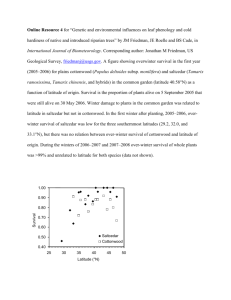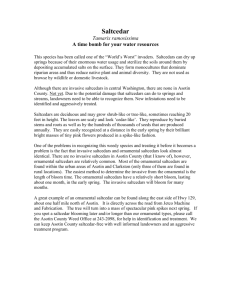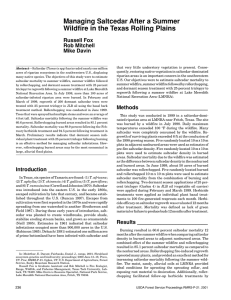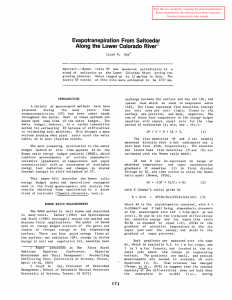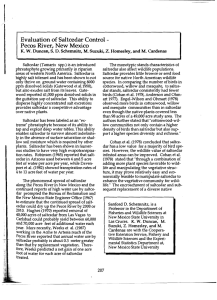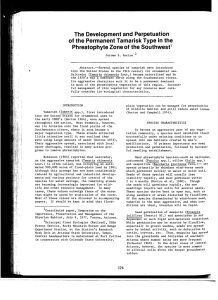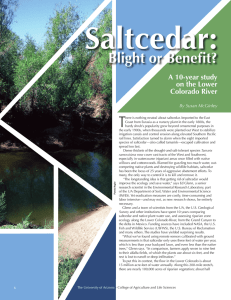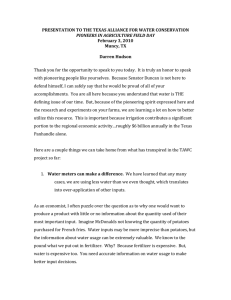Saltcedar Control and Water Salvage on the Pecos River,
advertisement
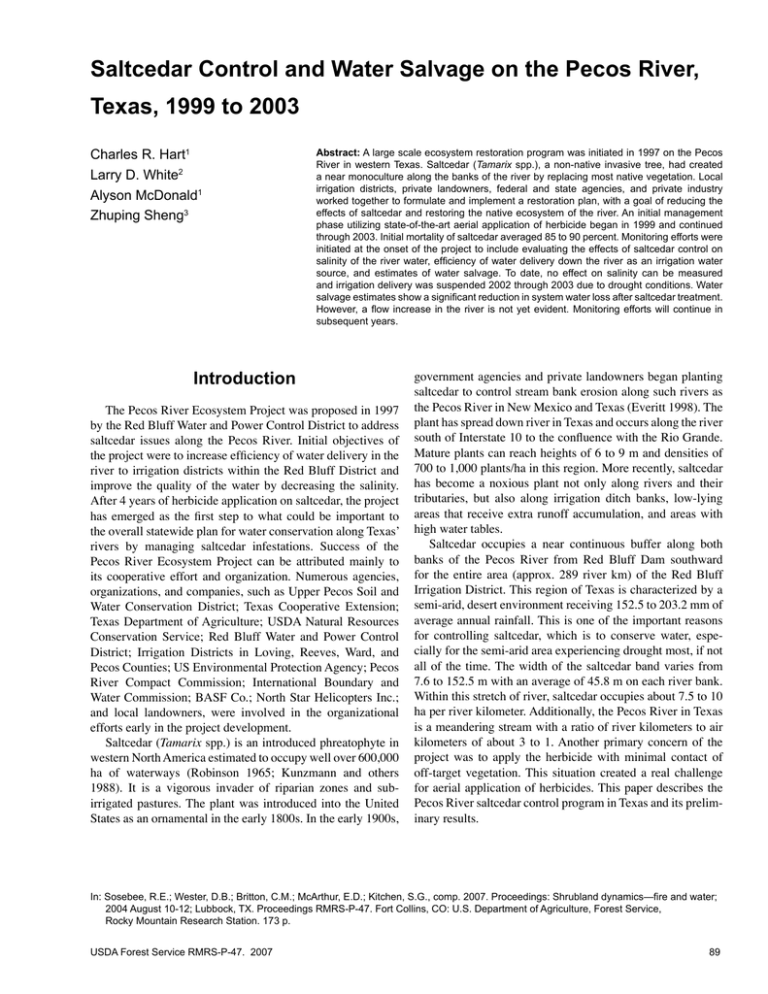
Saltcedar Control and Water Salvage on the Pecos River, Texas, 1999 to 2003 Charles R. Hart1 Larry D. White2 Alyson McDonald1 Zhuping Sheng3 Abstract: A large scale ecosystem restoration program was initiated in 1997 on the Pecos River in western Texas. Saltcedar (Tamarix spp.), a non-native invasive tree, had created a near monoculture along the banks of the river by replacing most native vegetation. Local irrigation districts, private landowners, federal and state agencies, and private industry worked together to formulate and implement a restoration plan, with a goal of reducing the effects of saltcedar and restoring the native ecosystem of the river. An initial management phase utilizing state-of-the-art aerial application of herbicide began in 1999 and continued through 2003. Initial mortality of saltcedar averaged 85 to 90 percent. Monitoring efforts were initiated at the onset of the project to include evaluating the effects of saltcedar control on salinity of the river water, efficiency of water delivery down the river as an irrigation water source, and estimates of water salvage. To date, no effect on salinity can be measured and irrigation delivery was suspended 2002 through 2003 due to drought conditions. Water salvage estimates show a significant reduction in system water loss after saltcedar treatment. However, a flow increase in the river is not yet evident. Monitoring efforts will continue in subsequent years. Introduction The Pecos River Ecosystem Project was proposed in 1997 by the Red Bluff Water and Power Control District to address saltcedar issues along the Pecos River. Initial objectives of the project were to increase efficiency of water delivery in the river to irrigation districts within the Red Bluff District and improve the quality of the water by decreasing the salinity. After 4 years of herbicide application on saltcedar, the project has emerged as the first step to what could be important to the overall statewide plan for water conservation along Texas’ rivers by managing saltcedar infestations. Success of the Pecos River Ecosystem Project can be attributed mainly to its cooperative effort and organization. Numerous agencies, organizations, and companies, such as Upper Pecos Soil and Water Conservation District; Texas Cooperative Extension; Texas Department of Agriculture; USDA Natural Resources Conservation Service; Red Bluff Water and Power Control District; Irrigation Districts in Loving, Reeves, Ward, and Pecos Counties; US Environmental Protection Agency; Pecos River Compact Commission; International Boundary and Water Commission; BASF Co.; North Star Helicopters Inc.; and local landowners, were involved in the organizational efforts early in the project development. Saltcedar (Tamarix spp.) is an introduced phreatophyte in western North America estimated to occupy well over 600,000 ha of waterways (Robinson 1965; Kunzmann and others 1988). It is a vigorous invader of riparian zones and subirrigated pastures. The plant was introduced into the United States as an ornamental in the early 1800s. In the early 1900s, government agencies and private landowners began planting saltcedar to control stream bank erosion along such rivers as the Pecos River in New Mexico and Texas (Everitt 1998). The plant has spread down river in Texas and occurs along the river south of Interstate 10 to the confluence with the Rio Grande. Mature plants can reach heights of 6 to 9 m and densities of 700 to 1,000 plants/ha in this region. More recently, saltcedar has become a noxious plant not only along rivers and their tributaries, but also along irrigation ditch banks, low-lying areas that receive extra runoff accumulation, and areas with high water tables. Saltcedar occupies a near continuous buffer along both banks of the Pecos River from Red Bluff Dam southward for the entire area (approx. 289 river km) of the Red Bluff Irrigation District. This region of Texas is characterized by a semi-arid, desert environment receiving 152.5 to 203.2 mm of average annual rainfall. This is one of the important reasons for controlling saltcedar, which is to conserve water, especially for the semi-arid area experiencing drought most, if not all of the time. The width of the saltcedar band varies from 7.6 to 152.5 m with an average of 45.8 m on each river bank. Within this stretch of river, saltcedar occupies about 7.5 to 10 ha per river kilometer. Additionally, the Pecos River in Texas is a meandering stream with a ratio of river kilometers to air kilometers of about 3 to 1. Another primary concern of the project was to apply the herbicide with minimal contact of off-target vegetation. This situation created a real challenge for aerial application of herbicides. This paper describes the Pecos River saltcedar control program in Texas and its preliminary results. In: Sosebee, R.E.; Wester, D.B.; Britton, C.M.; McArthur, E.D.; Kitchen, S.G., comp. 2007. Proceedings: Shrubland dynamics—fire and water; 2004 August 10-12; Lubbock, TX. Proceedings RMRS-P-47. Fort Collins, CO: U.S. Department of Agriculture, Forest Service, Rocky Mountain Research Station. 173 p. USDA Forest Service RMRS-P-47. 2007 89 Methods and Procedures The first step undertaken by the planning group was to develop a section 24(C) special use label to use Arsenal™ herbicide on saltcedar within rangeland and aquatic areas in Texas. The label was prepared by the Pesticide Division of the Texas Department of Agriculture and approved for use in 1999. The project was designed with two major phases, saltcedar treatment phase and debris removal and followup management phase. Also of major concern to the project group was the revegetation of the river banks with native plants to complete the ecosystem restoration. Once the label and funding were secured, the project was ready to begin the first phase of herbicide treatments. The Upper Pecos Soil and Water Conservation District Board of Directors were selected to administer the project. During the initial meetings to begin planning the process of saltcedar removal, several major concerns emerged. First, the treatment method selected should provide a high rate of saltcedar mortality while minimizing the detrimental effects on existing native vegetation. Second, this should be accomplished in the most economical way possible. And finally, soil loss from stream banks should be minimized as much as possible. Another daunting task was to obtain permission from private landowners to treat saltcedar along the river, as much of the land is in private ownership. A “spray easement” was developed and used as a contract between the Project and private landowners, allowing access for treatment and follow-up management for a 10-year period. To date, over 800 easements have been signed by private landowners, with a rejection rate of less than 1 percent. Bids were solicited from aerial applicators in late summer 1999 with the project ultimately being awarded to North Star Helicopters from Jasper, Texas. With funding, landowner permission, and applicator contract in hand by August 1999, initial treatments could begin in September. The ecohydrological study was conducted after the application of herbicide to assess impacts of saltcedar control in terms of water quality and water quantity. To quantify water flow between surface water and ground water, surface water flow release and diversions were monitored and groundwater level diurnal fluctuations were monitored at both treated and untreated sites. The latter were used to estimate the water losses by evapotranspiration and water salvage potential from the saltcedar control. Details for each component are described in this paper. Herbicide Applications Applications of 1.12 kg a.i./ha of Arsenal™ herbicide were made by helicopter, applied with a specially-designed boom that produced large droplets and high total spray volume. The helicopter had the advantage of being able to fly at slower air speeds compared to fixed-wing aircraft, which made the sharp turns of the river much easier to navigate. The helicopter application also provided for much higher precision of application by utilizing specialized nozzle and boom technology. 90 The herbicide was applied in a total spray volume of 140 L per hectare with a 1000 to 1500 µ droplet. Less than 0.5 percent of the droplets were “driftable” fines (< 200µ). The boom was also sectioned into 3 to 4.5 m sections for an overall width of 13.5 m. Combinations of the boom could be turned on to allow for a 4.5, 9, or 13.5 m swath width. This further reduced the amount of herbicide that came in contact with off-target vegetation. Another advantage of the helicopter over fixedwing aircraft was its ability to land on loader trucks that were positioned near the river and eliminated the need of ferrying to and from a landing strip. Helicopters were equipped with GPS navigational equipment to aid in application. The use of on-board GPS allowed for near elimination of skips between spray swaths and allowed pilots to easily return to the point where they finished spraying the previous spray load. The system was also connected into the sprayers flow control system so that rate of flow through the boom was varied to precisely match ground speed, eliminating the need to maintain a constant ground speed. After completion of treatments, GPS log files were downloaded to a computer to produce maps of the treated area and make calculations about the area treated. Percent mortality of saltcedar plants was estimated after a minimum of 2 years post-treatment. Counts were conducted at multiple locations to determine percent mortality of saltcedar by counting live and dead plants along belt transects on both sides of the river. If any green plant tissue was evident on a plant, it was recorded as live. Plants were counted within a 2.5-m wide belt transect until 100 plants were recorded as live or dead. A minimum of four transects were conducted at each sample location, two on each side of the river. Measuring Water Quantity/Flow Water quantity is monitored through release and delivery data from Red Bluff Water and Power Control District. Water released from Red Bluff Reservoir and delivered to seven local irrigation districts along the Pecos River is recorded daily during the irrigation season in ac-ft. Release and delivery data is obtained from weirs located at point of release from Red Bluff Reservoir and at each irrigation turnout point on the river. Historical release and delivery data have also been provided by the Red Bluff Water and Power Control District, with pre-treatment averaged from 1988 through 1999 to establish a comparative baseline. Flow data is obtained from United States Geological Survey (USGS) Gauging Station 13257 located at Girvin, Texas. This gauging station is located at the southern end of the Red Bluff Water and Power Control District boundary. Water released from Red Bluff Reservoir that is not delivered to upper districts is captured at Imperial Reservoir, located upstream from the USGS gauging station. Estimating Water Salvage Water loss resulted from evapotranspiration within saltcedar stands and water salvage from saltcedar control is estimated by monitoring groundwater diurnal fluctuations within saltcedar USDA Forest Service RMRS-P-47. 2007 6am 12noon 6pm 12midnight Figure 1. Conceptual illustration showing diurnal fluctuation in groundwater and representation of drawdown-recharge method for calculation of water loss. B A Groundw ater recharge rate Hourly Transpiration Loss (HTL) Daily water use = HTL X Specific Yield sites. Shallow groundwater monitoring wells were installed at a study site located on the Pecos River near Mentone, Texas, to provide data on the fluctuation of the groundwater table. A description of methods used to construct monitoring wells is provided in Hays (2003). Water level loggers (Global Water Instrumentation, Inc. Model WL14X) were used to measure hourly water levels in the wells and the river. The sensor on the WL14X is a submersible pressure transducer that is amplified and temperature and barometric pressure compensated with an accuracy of 0.2 percent. Logger models used in this study had a reported accuracy of 0.0091 m and were calibrated prior to being placed in the wells. Additionally, wells were cleaned and flushed annually to remove silt and root accumulation. Loggers were programmed to record water level every hour. A drawdown-recharge method (fig. 1) of calculation was used to estimate water loss from hourly measurements that produced diurnal fluctuations in the water table. This method assumes little evapotranspiration occurs during the nighttime (21:00 to 08:00 hours) and that the period from the low point of the water table during daylight hours to the nighttime high can be used to calculate a recharge rate for the drawdown period. This method requires a drawdown and recharge diurnal cycle; hence, days when the water table rapidly rises or falls through out the diurnal cycle were excluded from the calculations. More information on the procedures and calculations used are found in Hays (2003). A paired-plot design was used, with four monitoring wells and a river monitor at each of two plots. Each plot was monitored for an entire growing season (December 1999 through September 2001). The relationship between wells across plots was established through simple linear regression and reported by Hays (2003). In September 2001, one plot was treated with Arsenal™ herbicide and the saltcedar killed. When sufficient data are available, water loss on untreated plots will be used to predict that on untreated plots, and a comparison made between predicted and actual. To date, this calculation has USDA Forest Service RMRS-P-47. 2007 not been performed due to low water releases for the latest 2 years. Results and Discussion Based on field observation and data analysis over the last 3 years, the following preliminary results were obtained for herbicide application, water quality, water losses by evapotranspiration, and water salvage potential by saltcedar control. Additional research is also recommended to gain a better understanding of the impacts of saltcedar control and quantifying volume and fate of water salvage by saltcedar control. Herbicide Applications The project was funded in 1999 and 2000 by Red Bluff Water and Power Control District and irrigation districts along the Pecos River. Approximately 106 river kilometers or about 544 hectares of saltcedar were treated with an actual spray cost of $253,555. During 2001, $1 million was allocated to the Pecos River Ecosystem Project by the State of Texas through the Texas Department of Agriculture. Eight percent (8 percent) of these funds were used for project administration and monitoring with the remaining 92 percent used for saltcedar treatments in 2001 and 2002. Third year (2001) applications treated approximately 92 river kilometers or 583 hectares of saltcedar at a cost of $263,000. From 1999 through 2001, 1127 hectares of saltcedar were treated at a total cost of $515,635. Fourth-year applications were completed in September 2002. Approximately 1,444 ha were treated including segments of the river between Red Bluff and Grandfalls, Texas, that were not sprayed during the previous years, from the New Mexico/ Texas state line to Red Bluff Reservoir (including areas around the lake) and 8 kilometers of Salt Creek, a major tributary of 91 Figure 2. Areas of the Pecos River Basin treated for saltcedar control during 19992003. the Pecos River in Reeves County. About $660,000 was spent during the 2002 spray season. Applications in 2003 were funded through a joint effort of the USDA-NRCS Environmental Quality Incentives Program (EQIP) and Texas State Soil and Water Conservation Board Brush Control Program. EQIP is a private landowner based program for cost share of environmental practices. This program provided 75 percent of the saltcedar treatment costs to the landowner. The Texas State Soil and Water Conservation Board provided the remaining 25 percent of the cost through the Texas Brush Control Program. During 2003, approximately 1,510 hectares of saltcedar were treated within the Pecos Basin Watershed in Culberson, Reeves, Ward, Crane, Pecos, Crockett, Terrell, and Val Verde counties. Of this area treated, approximately 122 kilometers or 1,080 ha were along the main river channel. The remaining hectares were treated along tributaries and springs within the basin. Treatment cost during 2003 was $518.70/ha for a total of $783,300. To summarize, from 1999 through 2003, 320 kilometers of the Pecos River and various tributaries and springs within the basin have been treated for saltcedar control in Texas (fig. 2). Approximately $1.9 million was spent to treat 4,081 ha. Debris removal and follow-up management continues to be a priority to complete the project and this phase is currently being planned. Percent mortality estimates were made during the summer of 2002 at six sites along the river treated in 1999 and 2000. Average estimated mortality within a site ranged from a low of 84 percent to a high of 90.7 percent after herbicide applications. Across all sample sites, saltcedar mortality averaged 92 87.5 ± 0.1 percent 2 years after treatment. These results are very close to other studies (Duncan and McDaniel 1998). Water Quantity/Flow One priority was to determine if a relationship existed between water released at Red Bluff Reservoir and the amount of flow measured at Girvin. A coefficient of determination was calculated on flow (cfs) measured at Girvin and the volume of water (cfs) released from Red Bluff Reservoir, where r2 = 0.15 (P < 0.05). A low correlation provides evidence that release from Red Bluff Reservoir is at best only weakly related to flow through the USGS station at Girvin (Clayton 2002). After it was determined that losses occurring between release and delivery were not highly correlated to the flow at Girvin, only release and delivery data were analyzed and the Girvin data were not utilized in the analysis. It was observed that during certain time periods within a delivery year, percent loss changed considerably (fig. 3). This pattern precipitated dividing the irrigation delivery year into three categories, initial release and delivery (first month), release and delivery during the growing season, and later release and delivery (later irrigation season). Initial releases did not occur during the same month each year but varied between March and April. Delivery months were then numbered consecutively from the first month of release each year. The three categories allowed for a characterization of changes in percent loss occurring during the delivery year. A monthly average was calculated for each of the three delivery categories (table 1). The first month releases USDA Forest Service RMRS-P-47. 2007 Average Monthly Release and Percent Loss for the Pecos River 1988-1999 100% 14,000 12,000 90% 11,885 11,524 80% 10,541 8,000 6,000 70% 8,200 7,815 60% 4,934 5,014 4,528 4,000 40% 4,657 3,565 2,735 1,841 2,000 - 50% 6,241 1 2 3 Red Bluff Release (y1) 4 5 Loss Ac-Ft 10,000 6 30% 2,095 2,064 1,404 1,449 7 Month of Release and Delivery Water Balance Difference (y1) 3,779 8 9 20% 10% 0% Percent Loss (y2) Figure 3. Average monthly release, delivery, and percent loss of Pecos River irrigation water during consecutive delivery months from 1988 through 1999, with standard deviations of percent loss illustrated. averaged 7,862 ac-ft with a delivery of 2,927 ac-ft and resulted in an average percent loss of 68 percent. Monthly releases increased during the growing season to an average of 11,015 ac-ft, but losses decreased to 39 percent. Average release for the late season showed to be the lowest, 3,534 ac-ft, with a loss of 43 percent. It is obvious that much of the release during the first month is used to “re-charge” the banks that were naturally “drained” during the non-irrigation winter months. This initial loss can account for a significant amount of the water lost during the irrigation delivery year. An average pattern of release and percent loss was also determined for each month from 1988 through 1999 during the period of a delivery year. The highest average loss occurred during the first month (67 percent) of release. Percent loss decreased during the second month of release, and for the next 5 months of release, the loss ranged from 32 percent to 47 percent. However, when the amount of Table 1. Average monthly release, delivery, and percent loss for three release and delivery periods for the Pecos River from 1988 to 1999. Average monthly (acre-feet) Delivery period Release Delivery Percent loss First month Growing season Late season 7,862 11,105 3,534 2,927 6,648 2,074 68% 39% 43% USDA Forest Service RMRS-P-47. 2007 water released begins to decrease in month 7, the percent loss begins to increase (46 percent) and by month 9, the loss increased to 64 percent. Ultimately, this release and delivery data from pre-treatment years will be compared to post-treatment years to determine if control of saltcedar decreases the loss of water during the irrigation period thereby increasing the delivery efficiency. Only a small portion of the Red Bluff District had been treated during 2000-2001 delivery years. During the 2002 and 2003 delivery season, no water was released from Red Bluff Reservoir for delivery to irrigation districts. As irrigation delivery resumes, comparisons of pre-treatment to post-treatment will be made. Estimating Water Salvage Shallow groundwater wells have been monitored during the 2001 through 2003 growing seasons. Total water loss is calculated for each of the two plots for each year monitored. During the 2001 growing season, irrigation water was released as normal from Red Bluff Reservoir, but no irrigation water was released during the 2002 and 2003 seasons. Due to the lack of river flow during the 2002 and 2003 growing seasons, several of the wells were dry during the year; hence, only the wells closest to the river are reported at this time. Herbicide treatment was applied to plot A at the end of the 2001 growing season. Nearly 90 percent control of all vegetation was observed at this plot after the 2002 93 Untreated Site, July 2001-2003 6 5 2001 Figure 4. Shallow groundwater levels at sites A1 (Treated) and B1 (Untreated) during the month of July for the 2001 through 2003 growing seasons. Saltcedar on the treated site was killed after the 2001 growing season. Note the absence of diurnal fluctuations on the treated site during the 2002 and 2003 growing season. Water Level 4 3 2003 2 1 2002 0 Time Treated Site, July 2001-2003 6 5 2001 Water Level 4 3 2 2002 2003 1 0 Time growing season. Figure 4 shows the diurnal fluctuations in the groundwater table during July of each of the years for well locations A1 (treated plot) and B1 (untreated plot). Note that at well location B1, the diurnal fluctuations are evident for all 3 years. However, at well location A1, the diurnal fluctuations disappear during the 2002 and 2003 growing season. This is attributed to the fact that the saltcedar was killed on this plot after the 2001 growing season. Total water loss per year was calculated at 1.37 m at well location B1 and 0.95 m at well location A1 for the 2001 growing season (fig. 5). Water loss at well location B1 dropped due to drought to 0.89 and 1.0 m, respectively for 2002 and 2003. Water loss at well location A1 was reduced to 0.11 and 0.07 m, respectively for 2002 and 2003, after saltcedar treatment. Total water loss was greatly reduced following saltcedar control, although actual amount of salvage cannot yet be calculated. In addition, native plants take over some of the area where the saltcedar has been treated, which will further complicate the estimate of water salvage and its fate. Research will continue to document actual water loss and estimate amount and fate of salvaged water. Additional, updated 94 information on the project can be obtained from the Internet at the following web site: http://pecosbasin.tamu.edu Conclusions In summary, saltcedar control using the herbicide application described was successful with an average of 85 to 90 percent apparent mortality of saltcedar 2 years after treatment. With long-term monitoring, treatment life of the control strategies should be further evaluated and follow-up management alternatives explored. Preliminary results indicate that there is a great potential for water salvage by saltcedar control even though no fixed values were obtained for amount of water salvage, nor is the fate of the salvaged water identified. It is recommended that additional studies on surface water and shallow ground water interaction be conducted to have a better understanding of the fate of the potentially salvaged water. Additional study is also recommended to explore and validate the methodology for assessment of water salvage. USDA Forest Service RMRS-P-47. 2007 3.50 2.96 3.00 Figure 5. Total annual groundwater loss from Site A (Treated) and Site B (Untreated) for three growing seasons. Site A saltcedar was treated after 2001 growing season and shows dramatic decrease in water loss. Site B remains untreated through 2003. (Meters) 2.50 2.00 2.03 1.94 1.72 1.50 1.00 0.50 0.17 0.00 2001 0.04 2002 Site B (Untreated) 2003 Site A (Treated) This paper presents preliminary results of an ongoing project. Besides above-mentioned recommendations, the authors also identified several other related issues that should be addressed in future studies. One of the factors that affect assessment of the water salvage is the drought in the region. To overcome such an effect, long-term monitoring is recommended to gain a better understanding of the fate of salvaged water during the wet period. The second factor is re-vegetation or taking-over of the riparian zone by native plants, which could use some of the water salvaged by saltcedar control. Therefore, how much water is needed by native plants should be considered in estimate of long-term water salvage. Acknowledgments Research and monitoring efforts on the Pecos River Ecosystem Project were funded by a grant from the Texas Department of Agriculture and by the Rio Grande Basin Initiative administered by the Texas Water Resources Institute of the Texas A&M University System Agriculture Program with funds provided through a grant from Cooperative State Research, Education, and Extension Service, U.S. Department of Agriculture, under Agreement No. 2001-45049-01149. Duncan, K. W.; McDaniel, K. C. 1998. Saltcedar (Tamarix spp.) management with Imazapyr. Weed Technology. Vol.12, Issue 2:337-334. Everitt, Benjamin L. 1998. Chronology of the spread of tamarisk in the central Rio Grande. Wetlands. 18(4):658-668. Hays, K. B. 2003. Water Use by saltcedar (Tamarix sp.) and associated vegetation on the Canadian, Colorado and Pecos Rivers in Texas. Texas A&M University, Masters Thesis. 115 p. Kunzmann, M. R.; Johnson, R. R.; Bennett, P. S. Technical coordinators. 1988. Tamarisk control in southwestern United States; 1987 September 2-3; Tucson, AZ. Special Report No. 9. Tucson, AZ: National Park Service, Cooperative National Park Resources Studies Unit, School of Renewable Natural Resources: 141 p. Robinson, T. W. 1965. Introduction, spread, and areal extent of saltcedar (Tamarisk) in the western states. U.S. Geol Serv. Prof. Paper 491-A. 12 p. The Authors 1 Texas Cooperative Extension, Fort Stockton, TX. cr-hart@tamu.edu Retired, Texas Cooperative Extension, College Station, TX. 3 Texas Agricultural Experiment Station, El Paso, TX. 2 Literature Cited Clayton, L. 2002. Saltcedar Management Strategies and Effects on Water Quality and Quantity of the Pecos River. Texas A&M University, Masters Thesis. 86 p. USDA Forest Service RMRS-P-47. 2007 95
